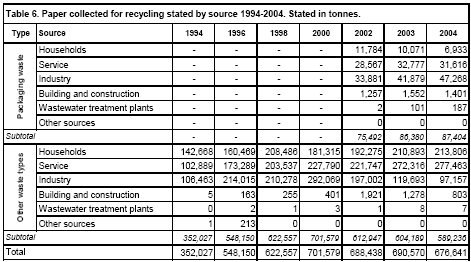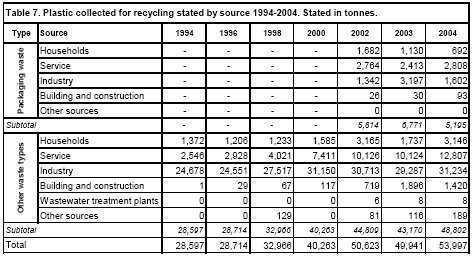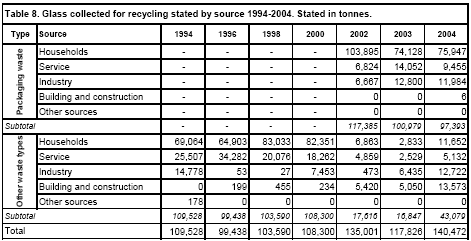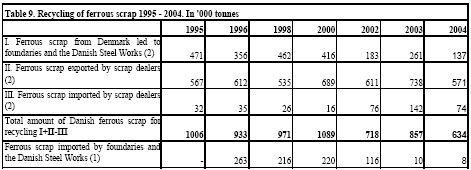|
Environmental Review, 1/2006 2 Recycling
2.1 Recycling by fractionTable 4 shows the amounts separated from the different waste fractions for the purpose of recycling in the form of either reprocessing, composting or biogasification. The Table does not show the total amount of waste generated by the individual fraction. Source: the ISAG and (1) Recycling industries and other large scrap dealers. (2) Elsam and Energi E2. (3) Reports to the Danish EPA on sludge from municipal wastewater treatment plants applied to farmland etc. Data has been delayed a year so that 2002 figures are used for 2003 and 2004, and 2001 figures are used for 2002 (see also 5.6. Sludge for long-term storage has been included in the amount for recycling. (4) To avoid double reporting, figures have been corrected for ferrous metal removed from waste incineration plants. The Table shows that in 2004 8,738,000 tonnes of waste were recycled. This is 7 per cent, or 594,000 tonnes, more than in 2003. The increase is primarily due to more recycling of soil and stone and other construction/demolition waste. Fly ash and slag from coal-fired power plants fell by 239,000 tonnes. Otherwise, there are no large fluctuations evident for the individual fractions. 2.2 Paper and cardboardConsumption of virgin paper and the rate of collection of waste paper in the period from 1994 to 2004 are shown in Table 5. The total amount of waste paper collected in 2004 amounted to 677,000 tonnes. This constitutes a reduction of 14,000 tonnes or 2 per cent relative to the amounts collected in 2003. Source: (1) Statistics on collected waste paper and cardboard 2003. Danish EPA, Environmental Project No. 1017, 2005 (not available in English). (2) ISAG reports. (3) Statistics Denmark. In Waste Statistics 2001, net exports of collected waste paper were stated as 258,000 tonnes. The final figure from Statistics Denmark was 316,000 tonnes. (4) Some of the increase from 1998 to 2000 is explained by corrections to ISAG reports. Thus, about 100,000 tonnes were diverted from secondary sources to primary sources in connection with quality control of reporting in 2000. The relevant waste treatment plants (probably) also reported incorrectly in previous years, which may account in part for previous differences in amounts of collected waste paper in statements based respectively on ISAG and material flow monitoring of collected waste paper (Danish waste paper delivered to Danish paper mills and net exports of waste paper). This rise in the amount of waste paper from trade/offices, along with the drop in the amount of paper from households, is probably due to the reporting plants having difficulties determining whether the waste should be reported as coming from primary or from secondary sources. In connection with the quality control, Smørum Papir, for example, stated that they no longer receive waste paper from households. This alone accounts for a fall of 45,000 tonnes compared to 2000. Apparently, no other plant has reported a compensating increase. Table 6 shows collected paper by source and by packaging waste and remaining waste types. Not surprisingly, the largest amounts of waste paper are collected from households, the service sector and industry. The largest amounts of packaging waste are collected from industry.
Source: ISAG reports 1994-2004. Note that double reporting in 1998 apparently explains why the total amount is about 20,000 tonnes too high. The total amounts of waste paper and cardboard for 2000 and 2001 were reported incorrectly in Waste Statistics 2001. The corrected figures have been included in Table 6. Packaging waste is a new waste type in the ISAG and it does not yet reflect the total amount of cardboard packaging waste collected for recycling in Denmark. In 2003, 298,000 tonnes of paper and cardboard packaging waste were collected for recycling [15]. There is almost no change in the amount of waste paper collected from households in the period 2003 to 2004. As can be seen, historically the amount of waste collected from households has been subject to some fluctuations throughout the period, increasing to around 221,000 tonnes in 2004. The amount of paper collected from the service sector has gone up by around 3,986 tonnes, or 1 per cent, amounting to 309,079 tonnes in 2004. The amount of paper collected from industry has fallen by around 17,148 tonnes corresponding to 11 per cent compared to 2003. In the ISAG, waste delivered to a recycling centre/transfer station is reported with the commercial source "recycling centre/transfer station". This means that it is not stated whether the waste originated from households or from other primary commercial sources. From 2001, recycling centres/transfer stations must indicate a split between waste types and primary source. Since this is not yet routine, the ISAG Secretariat has divided the waste as shown in Annex 2. 2.3 PlasticTable 7 shows the amount of plastic collected for recycling, reported to the ISAG. In 2004 this amount was 53,997 tonnes, which is an increased of around 4,056 tonnes from 2003. However, it is assumed that some plastic has been collected and exported directly for recycling abroad without having been registered at a Danish treatment plant. It is therefore probable that the amount of waste plastic collected in Denmark is higher than 53,997 tonnes.
Source: ISAG reports 1994-2004. The fraction plastic covers both production waste, plastic packaging waste, and other plastic waste, with individual figures shown in Table 7. Packaging waste is a new waste type in the ISAG and it does not yet reflect the total amount of waste plastic packaging collected for recycling and reprocessing in Denmark. Therefore, in the following description of plastic recycling, ISAG figures have been supplemented with information from more detailed statistics on waste plastic packaging. Statistics for waste plastic packaging in 2003 show that 20,018 tonnes of waste plastic packaging were reprocessed in Denmark in 2003 [16]. About half of this amount was imported. In 2003, 26,998 tonnes of waste plastic packaging were collected and recycled in Denmark. Of this amount, 16,259 tonnes were exported for recycling abroad. The total amount collected corresponds to 17.4 per cent of the total Danish consumption of plastic packaging. This constitutes an increase from 2002, when 15.5 per cent of waste plastic packaging was collected for recycling. Waste plastic of the type polyethylene (PE) accounted for 83 per cent of collected amounts. 2.4 Bottles and glassAccording to the ISAG reports, 140,472 tonnes of bottles and glass were collected for recycling in Denmark in 2004. This is 22,646 tonnes more than in 2003. As seen in Table 8, the amount of glass collected for recycling went up by 30,944 tonnes, or 28 per cent, during the period 1994 to 2004. However, the figures fluctuate somewhat throughout the period. At the same time it is seen that the amount of glass packaging collected from households has dropped in the period 2002 to 2004.
Source: ISAG reports 1994-2004. It is evident from Table 8 that by far the major part of the glass collected is packaging waste: thus, packaging waste accounted for 69 per cent of the total amount of glass in 2004. However, the ISAG does not provide a complete picture of the overall material flow. This is especially significant with regard to recycling of bottles and glass, which is a process comprising several collection, reuse and treatment steps before glass becomes waste. Therefore, in the following description of overall glass recycling, ISAG information is supplemented with information from Statistics on glass packaging 2003, cf. Figure 6 [17].
Source: Statistics on glass packaging 2003. Environmental Project No. 1012, 2005. Note that total consumption for 1999 has been adjusted to reflect Statistics on glass packaging 1999. The adjustment is due to a write up of amounts of glass packaging for food preservation. Apart from minor fluctuations, consumption of glass packaging increased throughout the 1990s. Correspondingly, the amount of glass packaging collected and recycled has increased. The amount of glass collected was 137,000 tonnes in 2002. The same amount was collected in 2003. The amount of recycled glass increased; from 135,000 tonnes in 2002 to 137,000 tonnes in 2003. This means that in 2003 the collection rate as a percentage of total consumption reached 68 per cent, which means a 3 per cent drop from 2002. In 2002, the recycling rate as a percentage of total consumption reached 68 per cent. Bottles for beer and soft drinks manufactured for reuse are not included in this statement. Refillable glass bottles, on average, make 30 trips. If these bottles were manufactured as single-use bottles, it would give an increase in waste glass of around 310,000 tonnes. 2.5 Ferrous metalTable 9 shows the overall amount of ferrous scrap collected, analysed between consignees. It is seen that 634,000 tonnes of ferrous metal were recycled in 2004, which is a decrease of 223,000 tonnes, or 26 per cent, from 2003.
Source: (1) ISAG reports, (2) information from the Association of Danish Recycling Industries and other large scrap dealers. Note that calculations in Table 9 differ from those in Table 4. Amongst other things, the figures have not been corrected for amounts of ferrous metal removed from waste incineration plants. 2003 as well as 2004 saw a substantial drop in imports of ferrous scrap by foundries and the Danish Steel Works. This is because the Danish Steel Works was closed down and therefore no longer contributes to the ISAG. Table 9 shows a drop from 2002 to 2004 of 108,000 tonnes, or 93 per cent, in the amount of ferrous scrap imported by foundries and the former Danish Steel Works. The Association of Danish Recycling Industries has reported that ferrous scrap not sent to the Danish Steel Works has been exported. However, the Association of Danish Recycling Industries normally estimates a recycling rate for ferrous scrap in excess of 90 per cent. According to reports to the Danish EPA, the Danish Steel Works and other Danish foundries imported 8,000 tonnes of ferrous scrap in 2004, whereas scrap dealers imported around 74,000 tonnes. In other words, total imports in 2004 amounted to 82,000 tonnes, which is 70,000 tonnes, or 46 per cent, less than in 2003. Scrap dealers exported 571,000 tonnes of ferrous scrap in 2004, which means that net exports in 2004 were 497,000 tonnes. This is a fall of 17 per cent from 2003. 2.6 Organic waste for composting, wood chipping and biogasificationThe amount of organic waste led to reprocessing in the form of composting, wood chipping, biogasification, or fodder is shown in Table 10. Organic waste led to reprocessing in 2004 amounted to 1,229,000 tonnes. This is 77,000 tonnes less than in 2003. This fall stems for a great part from added branches, leaves, etc. and added sludge for composting, which, together, have fallen by 317,000 tonnes. At the same time, the amount of sludge for Carbogrit has gone up by 172,000 tonnes. Source: the ISAG does not contain information on whether organic materials are reprocessed via composting, wood chipping or biogasification. Figures are based on assessments and calculations of data from the ISAG reports. According to calculations in Statistics on treatment of organic waste from households 2001, Environmental Project No. 856, 2003, organic domestic waste led to composting and biogasification amounts to 37,000 tonnes. The amount of bark/wood chips and compost removed from treatment plants does not reflect the total amount generated at the plants. Rather, this amount indicates the quantity sold or delivered free from the plants. As is seen from the table, the amount of sold/removed bark/wood chips came to around 13,000 tonnes less than in 2003, whereas the amount of sold/removed compost was 1,000 tonnes less than in 2003. 2.7 TyresIn 1995, the Minister for Environment and Energy entered an agreement with a number of organisations, on a take-back scheme for used tyres from cars, vans, and motorcycles. The purpose of the agreement is to ensure collection and recycling of used tyres in Denmark. In this way, landfilling is avoided and appropriate resource recovery ensured which prioritises recycling over energy recovery. The scheme commenced on 1 April 1995 and is financed by a fee on all tyres covered by the agreement and marketed in Denmark. According to the agreement, the target is a take-back rate of at least 80 per cent. From 1 April 2000 the scheme was extended to cover tyres from all types of motor vehicles. This accounts for the leap in data between 1998 and 2000 in Table 11. The table shows that in 2002 as well as in 2004 the collection rate for waste tyres surpassed 100 per cent. According to reports from the Danish Tyre Trade Environmental Foundation, this is presumably due to the fact that waste tyres have been imported from Germany, as well as to the fact that some waste tyres have been collected and stored for several years.
Source: reports from the Danish Tyre Trade Environmental Foundation in 1996, 1998, 2000, 2002, 2003 and 2004. Footnotes[15] Reporting of packaging waste to the EU. [16] Statistics on waste plastic packaging 2003. Environmental Project No. 1035, 2005. [17] Statistics on glass packaging 2003. Danish EPA. Environmental Project No. 1012, 2005.
|





